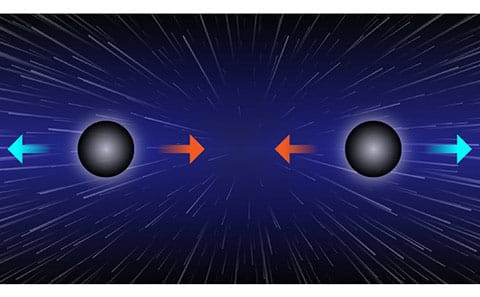Black holes are enormous celestial objects with such a powerful gravitational attraction that nothing can escape from them, not even light. Based on Einstein’s theory of general relativity, conventional black hole theories typically describe how static or spinning black holes can exist on their own, isolated in space. Black holes in pairs would eventually be stopped by gravity drawing them together and causing collisions.
This holds, though, if one thinks the Universe is still. How about one that is continually in motion? Could black hole couples coexist peacefully in an expanding universe, possibly posing as one?
Researchers from the Universities of Southampton, Cambridge, and Barcelona have demonstrated that it is theoretically conceivable for black holes to exist in perfectly balanced pairs, replicating a single black hole and being kept in equilibrium by a cosmic force.
Professor Oscar Dias of the University of Southampton said, “The standard model of cosmology assumes that the Big Bang brought the Universe into existence and that, approximately 9.8 billion years ago, it became dominated by a mysterious force, coined ‘dark energy,’ which accelerates the Universe at a constant rate.”

‘Cosmological constant’ is the term scientists use to describe this enigmatic force. Black holes are submerged in a cosmic accelerating background in a universe explained by Einstein’s theory with a cosmological constant. This raises the theoretical bar for how black holes can interact and coexist.
Scientists used complex numerical methods to show that two static black holes can exist in equilibrium – their gravitational attraction is offset by the expansion associated with a cosmological constant. The black holes stay locked at a set distance from one another even as the Universe expands faster and faster. The gravitational attraction balances out any attempts by expansion to separate them.
Professor Dias said, “Viewed from a distance, a pair of black holes whose attraction is offset by cosmic expansion would look like a single black hole. It might be hard to detect whether it is a single black hole or a pair of them.”
Professor Jorge Santos of the University of Cambridge adds: “Our theory is proven for a pair of static black holes, but we believe it could be applied to spinning ones too. Also, it seems plausible that our solution could hold for three or even four black holes, opening up a range of possibilities.”
Journal Reference:
Óscar J. C. Dias, Gary W. Gibbons, Jorge E. Santos, and Benson Way. Static Black Binaries in de Sitter Space. Physical Review Letters. DOI: 10.1103/PhysRevLett.131.131401
>>> Read full article>>>
Copyright for syndicated content belongs to the linked Source : Tech Explorist – https://www.techexplorist.com/black-holes-exist-perfectly-balanced-pairs/76179/#utm_source=rss&utm_medium=rss&utm_campaign=black-holes-exist-perfectly-balanced-pairs































